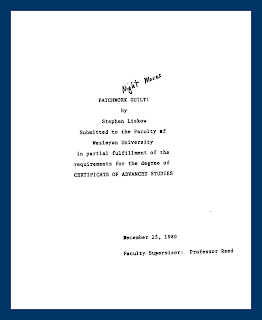It started with one hula hoop, eight writers drinking S.J. Rozan-inspired martinis all basking in ShortCon’s afterglow…
 |
| Dan White & S.J. Rozan with her Signature Martini |
There is something magical that happens when writers gather after a conference.
Maybe, it’s because of how we are wired. Maybe, it’s because of the creative energy that still lingers in the air—and we had plenty of it this year, thanks to the incredible presentations by S.J. Rozan, Jeffrey Marks, and Michael Bracken. Being together ignites our imaginations and fosters inspiration.
At Elaine’s Literary Salon that night was no different.
Conversations about the conference turned to hula hoops. I am still not sure what sponsored the now-infamous hula hoop-moment between Dan White and S.J. Rozan and the deep dive into iconic playground games and equipment that quickly followed.
Like so many similar moments when crime fiction writers are together, snippets of story ideas began bouncing around like a gaggle of kids on pogo sticks: hopscotch and chalk-lined bodies, Double-Dutch turned deadly, butt-burning metal slides, death-defying jumps from swings, and tether ball clashes. Some, reimagined the Tony Sopranos of the sandbox-world uttering,“What happens in the sandbox stays in the sandbox.” I can still hear the New Jersey-accent playing in my head.
We also discovered just like “regional words” exist for carbonated drinks (soda, pop, Coke), names for playground equipment vary, too: Seesaws or Teeter-Totters, Monkey bars or Horizontal Ladders, Spinners or Merry-Go-Rounds or Roundabouts, Spring Riders or Spring Rockers.
And the list goes on.
Others recounted playground politics and social hierarchies, what it felt like to be fearless, what it felt like to desperately want to be accepted—all of us reliving nostalgic and not so nostalgic moments from our childhood.
Less than an hour later, short story legend (aka Michael Bracken) roughed out a proposal for a crime fiction anthology where a piece of playground equipment or a playground game plays an important role. These had to exist on old-school playgrounds, where the playground was was made of asphalt and the equipment was made of metal, which likely meant these stories would be set in the past or in the present with flashbacks or in neighborhoods that had not upgraded to modern, safe playground equipment.
 |
| Michael Bracken exhausted by the "Idea Fairy" |
And just like that, Playground Noir: For the Kids Who Never Grew Up, was born.
Michael was surrounded by his list of contributors. He also had a publisher in mind.
As I write this post today, Michael has already pitched his proposal and awaits a response.
My key takeaways from that night at Elaine's:
Crime fiction writers are all a little twisted. Thank God, we have each other.
The best story ideas happen when writers gather to enjoy one another’s company.
It’s important to stick around after conferences and connect with fellow writers. You never know what is going to happen. You may become a contributor in an upcoming anthology.
***
 |
| Stacy Woodson with Dan White |
Want to make space for your own hula-hoop moment?
ShortCon 2026 is just around the corner.
Hosted by Michael Bracken, the conference will be held at Elaine's Literary Salon in Alexandria, Virginia on June 6, 2026.
Gary Phillips will lead a three-hour writing workshop on “Blueprinting Criminal Behavior.”
Michele Slung will present “Every Moment is a Story,” a behind-the-scenes look at putting together annual best-of collections.
Art Taylor will discuss “Linked, Intertwined, or Seamless: The Curious Case of the Novel in Stories.”
I will also lead an end-of-day panel discussion with the presenters. Registration opens in July.
You can find it here: https://www.eastcoastcrime.com/#/.
Hope to see you there!







.jpg)